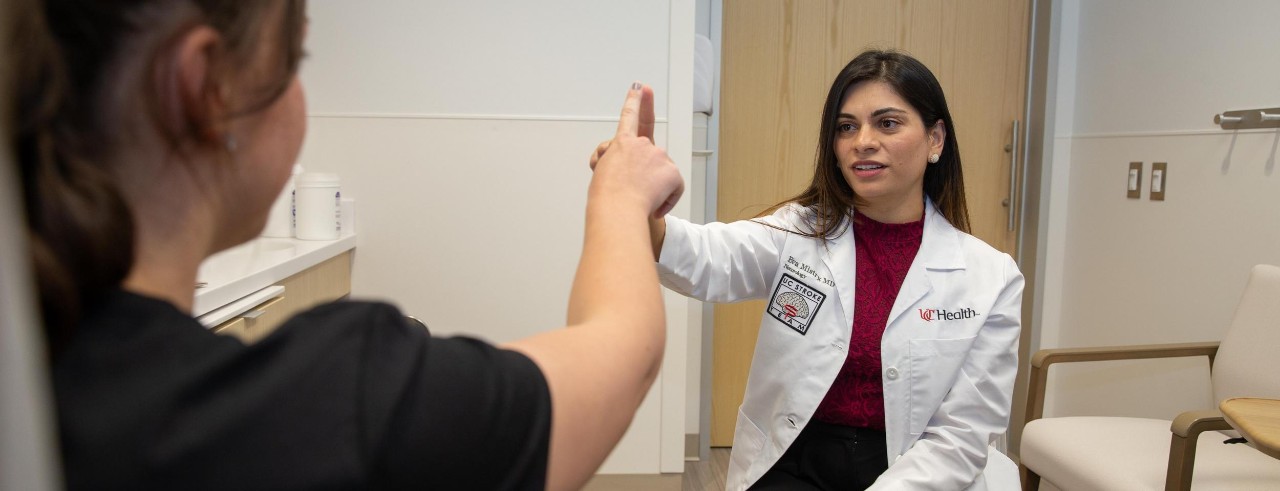
‘Designer drug’ shows early neuroprotective signal in acute ischemic stroke
UC research featured in Medscape article
Medscape highlighted new trial results led by the University of Cincinnati's Eva Mistry, MD, that found an experimental drug shows promise in protecting injured brain cells for patients with acute ischemic stroke. Mistry presented the results at the 17th World Stroke Congress 2025 Oct. 23.
The Phase 2 ARPEGGIO trial tested the drug Scp776, based on insulin-like growth factor 1 (IGF-1), which plays a key role in brain health by protecting neurons from excitotoxicity, hypoglycemic damage, oxidative stress, inflammation and apoptosis.
The trial enrolled 119 patients and randomized patients with acute ischemic stroke who underwent endovascular thrombectomy to either receive the drug administered intravenously or a placebo. Those treated with Scp776 showed a trend toward better National Institutes of Health Stroke Scale (NIHSS) scores, which measure stroke severity, at 7 days, and improved modified Rankin Scale (mRS) scores, which assess functional outcomes, at 90 days.
“This is a unique and innovative drug, and these early results are very exciting,” Mistry, associate professor of neurology in UC's College of Medicine and a stroke physician researcher at the UC Gardner Neuroscience Institute, told Medscape. “Attempts at finding a treatment that prevents the death of injured brain cells in stroke patients have so far not been successful. But we are hopeful that this could be different. This is a really exciting opportunity, and the implications are huge."
IGF-1 receptors are abundant throughout the body and are thought to play a key role in halting or reversing cell death, but naturally occurring IGF-1 doesn't remain in the body long. The "designer" version, Scp776, overcomes the limitation by having a longer halflife and being specially engineered and directed toward the site of injury.
Mistry said adverse events were evenly distributed between active drug and placebo participants, suggesting a "very reasonable" safety profile.
“Overall, the patients who were treated with the selected dose of the drug did better in terms of all three outcomes, with two showing particular benefit — stroke severity and 90 day functional outcome,” Mistry said.
“Targeting IGF-1 is a very promising approach," she continued. "Observational data that suggests that IGF-1 levels are associated with better outcomes in stroke patients, but it hasn’t been possible to safely and specifically develop this strategy before. But now with advanced bioengineering techniques, this is an option,” Mistry added.
Featured photo at top of Mistry with patient. Photo/Andrew Higley/UC Marketing + Brand.
Related Stories
UC marks 4 years saving lives with mobile stroke unit
August 15, 2024
The University of Cincinnati's Christopher Richards spoke with Local 12 about the four-year anniversary of the mobile stroke unit that can bring the emergency department directly to patients.
Trial finds new drug safe, effective to treat deadliest form of epilepsy
October 23, 2024
MSN highlighted research presented by the University of Cincinnati’s Brandon Foreman that found ganaxolone is a safe and effective treatment for refractory status epilepticus.
WLWT: UC hosts RESET epilepsy trial
May 3, 2023
WLWT spoke with the University of Cincinnati's Brandon Foreman about a clinical trial testing a new treatment for status epilepticus, the most severe and deadly form of epilepsy.
